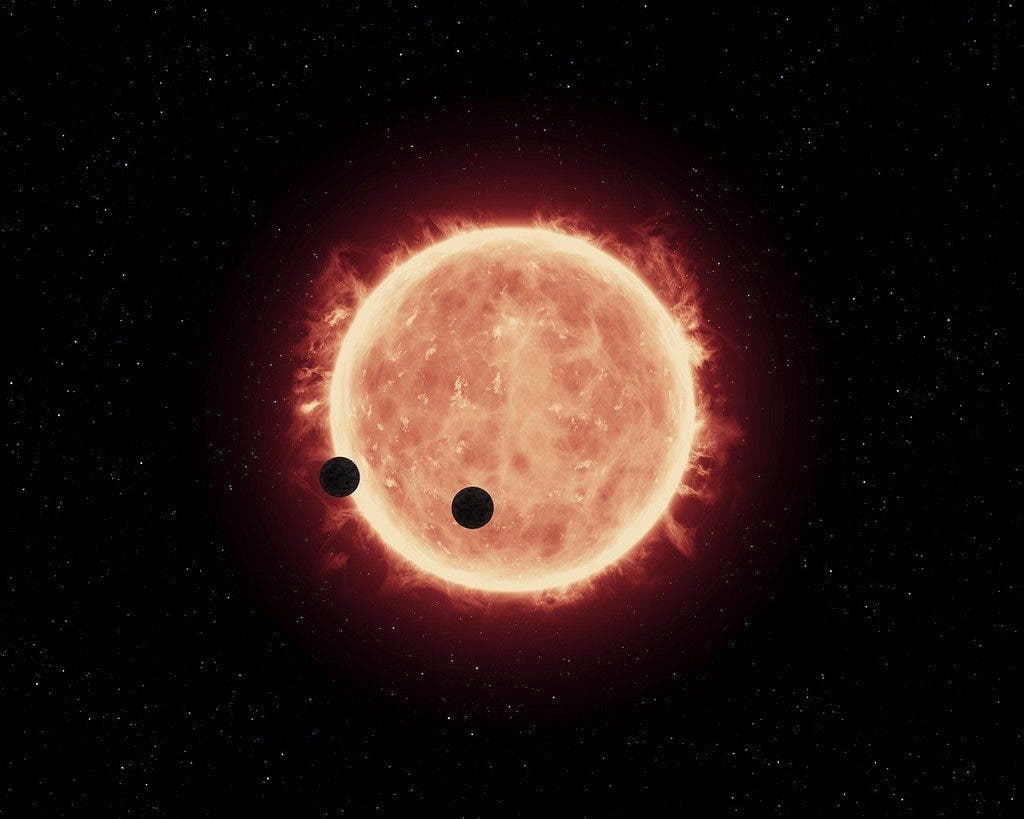Researchers report finding a new exoplanet orbiting a three-star system.

Artist’s view of planets transiting red dwarf star in TRAPPIST-1 system.
Image credits Hubble ESA / Flickr.
The excitingly-named LTT 1445Ab orbits one star from a group of three red dwarves that constitute the system LTT 1445, located around 22.5 light-years away. While definitely rocky in nature, high surface temperatures on LTT 1445Ab make it completely unwelcoming for life as we know it. However, researchers are still excited for the find — its atmosphere makes it a perfect test subject to help us refine our long-distance planetary analysis techniques.
LTT 1445Ab and the three red dwarves
“If you’re standing on the surface of that planet, there are three suns in the sky, but two of them are pretty far away and small-looking,” Jennifer Winters, an astronomer at the Harvard-Smithsonian Center for Astrophysics and the paper’s first author told New Scientist.
“They’re like two red, ominous eyes in the sky.”
Stars in multiple-star systems are gravitationally locked around a mutual center of gravity, which they all orbit. LTT 1445 is home to three such stars. The new exoplanet was discovered in this system by the Transiting Exoplanet Survey Satellite (TESS), NASA’s planet-hunting space telescope. TESS was designed to spot exoplanets as they pass between Earth and their home star by detecting the slight dimming the planet causes as it blocks part of the star’s light.
Based on the amount of dimming and on the tiny, almost imperceptible, movements stars make under the effect of an orbiting planet’s gravity (in the case of LTT 1445Ab this was measured with other telescopes than TESS), researchers can estimate the size and mass of the planet. The new planet is about 1.35 times the physical size of Earth but it packs up to 8.4 times Earth’s mass, so it’s a lot denser than our home planet.
Judging by its size and mass, this is definitely a rocky planet — like Earth, Venus, or Mars — not an ice or gas giant. However, don’t break out your colonizing gear just yet. The planet is so close to its host star that it only has a 5.36 day-long orbit. At this distance, surface temperatures likely hover around 428 Kelvin (155 °C; 311 °F), the authors report.
While LTT 1445Ab won’t be a welcoming home for us anytime soon, it’s still an exciting planet for astronomers because it might have an atmosphere. Rocky planets with atmospheres that transit in front of their stars are good test subjects for the detection tools we use to spot gases such as methane and carbon dioxide on alien worlds. Such a planet won’t just dim a star’s light as it transited in front of it but, based on the atmosphere’s chemical composition, would also change the properties of the light.
By analyzing at this change, researchers can estimate the chemical make-up of an alien world’s atmosphere. Our current technology and know-how in this field can still use some tweaking, one which LTT 1445Ab can help provide. With Hubble’s successor, the James Webb Space Telescope due to be launched in 2021, astronomers are already making a list of targets they’d like it to study. LTT 1445Ab could be a perfect candidate.
Among the properties that recommend it for this role is that it transits in front of its star very often, meaning the James Webb Space Telescope can take many readings in a short span of time. The planet is also relatively close in astronomical terms, which makes it easier to take high-quality images, and its red dwarf star is just right for this kind of observation — bright enough to back-light the atmosphere, but not so bright that the planet is hard to see.
Mind you, we don’t know whether LTT 1445Ab has an atmosphere or not right now. But even if it doesn’t, or if its atmosphere contains no biosignatures, it could tell us more about what we can expect to find on rocky planets that orbit red dwarfs.
The paper “Three Red Suns in the Sky: A Transiting, Terrestrial Planet in a Triple M Dwarf System at 6.9 Parsecs” has been submitted to the The Astronomical Journal and is available on the preprint server arXiv.









